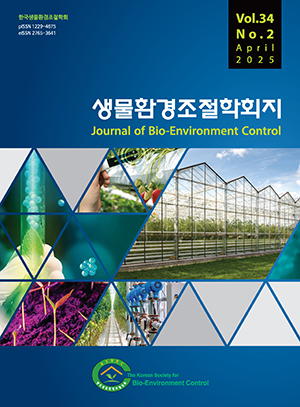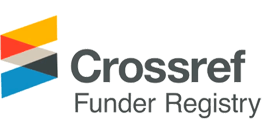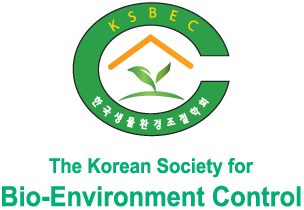Instructions for Authors
Korean Society for Bio-Environment Control (KSBEC) Submission Rules
Dec. 22. 1992 Establishment
Jan. 21. 2000 Amendment
Jul. 14. 2000 Amendment
May 12. 2006 Amendment
May 11. 2007 Amendment
Oct. 27. 2007 Amendment
Mar. 05. 2010 Amendment
Dec. 10. 2012 Amendment
Nov. 30. 2013 Amendment
Jun. 26. 2020 Amendment
- 1. The journal published by the Korean Society for Biological Environment Control is an official journal published four times a year and is published on January 31, April 30, July 31, and October 31 every year.
2. Qualification of Submission
2.1 The correspondent should be the members but non-members can be included in case of collaborative work.
2.2 Those who the first author (including those who co-first author) in the paper and those who correspondent must be members of the society.
2.3 Manuscripts should have academic or practical value and must have not been published elsewhere.
2.4 Papers submitted to the journal should be presented at KSBEC based upon the principle. However, unpresented manuscripts can be published if its value is accepted. The copyright of manuscripts belongs to KSBEC.
2.5 If the result of the KCI literature similar test shows that the plagiarism rate is more than 30%, the submission may be rejected.
3. Paper format
Article types can be original articles. The paper should be written in Korean or English and should be presented in the following format.
3.1 Korean manuscripts: Manuscripts can be written in Korean along with Chinese and must not exceed 12 pages. Manuscripts should be presented in the following order. Leave one line between orders
① Title, author name, affiliation (in Korean) ② Title, author name, affiliation (in Korean), position (in English), ③ Abstract, ④ Additional key words, ⑤ Corresponding author(If there are more than two authors), ⑥ Introduction, ⑦ Material and Methods, ⑧ Results and Discussion (Can be separated into Results and Discussion), ⑨ Abstract in Korean, ⑩ Additional key words, ⑪ Acknowledgement, ⑫ Literature cited, ⑬ Tables and Figures
3.2 English manuscripts: The number of pages is based upon the Korean manuscript. ① the title of the paper, the full name of the author, and the institutional affiliation (in English), a position in the workplace (in English) ② Abstract (same with Korean), ③ Additional key words, ④ Corresponding author(s) (if there are more than two authors), ⑤ Introduction, ⑥ Materials and methods, ⑦ Results and Discussion (Can be separated into Results and Discussion), ⑧ Acknowledgements, ⑨ Literature cited, ⑩ the title of the paper, the full name of the author, and the institutional affiliation (in Korean), ⑪ Abstract in Korean, ⑫ Additional key words (in Korean), ⑬ Tables and Figures
3.3 Format of Title page
3.3.1 Title: The title should be a concise description including the contents of the paper. The title should be avoided using series of papers if possible. Capitalize the first letter of all title words except articles, prepositions, and conjunctions. The title that starts with, ‘A study on….’ or ‘Studies on…’ cannot be used in an English title and in principle and commodity name or abbreviation should not be used. Use common names for well-known species. Cultivar names can only be used for inter-species comparisons or to emphasize the characteristics of the cultivars. Do not use an abbreviation except for common terminology.
3.3.2 Name(s) of Author(s): If there are more than two authors, each author’s names should be separated with using the middle dot. (ex. 김○○*·박○○). The last name can be written first with a comma before the first name. Also, the hyphen (-) can be used in the first name or not by authors. The corresponding author should be noted by an asterisk and specified in the footnote. If an author has since moved to a different institution, the new location can be indicated in a footnote.
3.3.3 Affiliation: It must be clear and in detail about the institution. If the institutions are different, they should be separated by a number (ex. 김○○1·박○○2). 1Department of Agricultural Engineering, Seoul National University, 2Department of Horticulture, Chonnam National University.
3.3.4 Position: When publishing a paper in this journal, it is also required to display the position and affiliation of the author in the paper. (e.g. professors (full/non-executive) - professors, university instructors – instructors, university students – students, post-doctoral researchers – post-doctoral researchers, if no affiliation/position – only name). In the case of minors who do not currently belong to the paper, the final affiliation, position, and school year are submitted and managed separately.
3.3.5 Footnote: When you need to explain the part of the specific tables and figures, it can be used.
3.3.6 Additional key words and sub-themes: The key words must be related to the article and should be around 5 words. It should be written in Korean and English. It should not be written in the title. Also, it should not include too broad or common words, such as quantity or growth, when you put the additional key words. In case of a scientific name, the name of the nomenclature should be excluded. The orders should be in Korean and English alphabetical order. For the English paper, when adding additional key words to the original, add them in order of the additional key words in Abstract.
3.3.7 Abstract: The Abstract should be a concise summation of the objectives, used materials and methods, results, and conclusions written in a paragraph. Abstract should not exceed 300 words. It should all be composed as one paragraph, and it should not be numbered. The Abstract should not contain any undefined abbreviations or unspecified references. The common name, chemical name, physiological or pathological term of a common species may be used.
3.3.8 Corresponding email and checking co-correspondent or not can be followed by the Additional key words.
3.4.1 The numbers should not be used in the Introduction, Materials and Methods, Results and Discussion, Abstract, and References. These elements should be located in the center. Each of them should have 1 row of space before the preceding text.
3.4.2 Introduction: The introduction should provide the necessary background information for the reader. The motivation and the purpose of the research, the research history, and the research trend are briefly explained. The purpose of the research should be the last part. A lengthy description and a simple repetition should be avoided. Previous publications that form a basis for the work presented must be cited.
3.4.3 Materials and Methods: It is required to provide the materials and method in detail related to the figures and tables. Use references when well-known methods are used. It is required to provide the scientific name of the plant materials. If necessary, the variety names can be presented. When indicating experimental equipments and sensors, etc., the model name, manufacturers and country name must be entered.
3.4.4 Results and Discussion: The results must be explained clearly and briefly using figures and tables. The quantitative changes are described by figures rather than tables. The discussion should be filled with the new and important information of the study and should be compared and analyzed to the known facts. If necessary, the results and the discussion can be separated into independent sections. Tables and graphs should be arranged one for each page after the reference.
3.4.5 Abstract in Korean: It is possible to write an additional abstract about the complex results in detail. However, it should follow the English Abstract.
3.4.6 Acknowledgement: It can be marked if necessary. Any grant that requires acknowledgement(s) should be mentioned. Acknowledgement(s) of help from colleagues and professional associates are appropriate, but avoid acknowledgement(s) of routine secretarial help or family members.
3.4.7 Literature cited: It contains academic journals, reports, books, dissertations, etc. which are regularly published. Whether the references is written either in Korean or English, the references should be written in only English. If it is not an English paper citation, the written language of the cited paper should be mentioned (ex. (in Korean)). Only cited references in the paper should be listed. In case of a recitation, it is required to present both the original author and the author who made the citation.
Text: Citation may be made directly or parenthetically. If references are made in the text listed in Literature Cited, refer to them by the author's family name(s) and the year published according to the Harvard system. The order of the references should be alphabetical (ex. in Chinese references, follow the Chinese pronunciation).
List: All literature cited should be listed in an alphabetical order, by the author’s family names. Each reference should be in the order of the author, year, title, publisher, volume, and the page number. Do not use an issue number if the journal uses consecutive for each volume. If the several articles under the same author were cited, the order of the articles would be ordered by years (earlier years should be at first). If the articles have more than two co-authors at the same year, the order of the articles would follow the alphabetical order of the co-author. If the articles have the same year and the same authors, it should be written with the year and the following lower case alphabet in order (ex. 1997a, 1997b). Journal names should be written in full name without abbreviation or be abbreviated according to the List of Title Word Abbreviations: http://www.issn.org/services/online-services/access-to-the-ltwa/, but those are abbreviated without period. DOI should be actively used and provided if the paper is published online. Note that the use of unpublished work by others (including information obtained in private communication(s)) requires their permission. Unnecessarily long lists of references, including excessive self-citation, should be avoided.
Please note the following examples.
(1) Journal Article
Garcia-Hernandez M., T.Z. Berardini, G. Chen, D. Crist, A. Doyle, E. Huala, E. Knee, M. Lambrecht, N. Miller, and L.A. Mueller 2002, TAIR: a resource for integrated Arabidopsis data. Funct Integr Genomics 2:239-253.
(2) Journal Article + DOI
German M.A., M. Kandel-Kfir, D. Swarzberg, T. Matsevitz, and D. Granot 2003, A rapid method for the analysis of zygosity in transgenic plants. Plant Sci 164:183–187. doi:10.1016/S0168-9452(02)00381-3
(3) Electronic Article
Chen W.H., X.M. Zhao, V. van Noort, and P. Bork 2013, Human monogenic disease genes have frequently functionally redundant paralogs. PLOS Comput Biol 9:e1003073
(4) Online-First Article
Weeks D.P., M.H. Spalding, and B. Yang 2015, Use of designer nucleases for targeted gene and genome editing in plants. Plant Biotechnol J (in press). doi:10.1111/pbi.12448
(5) Patent
Ubersax J.A., and D.M. Platt December 9, 2010. Genetically modified microbes producing isoprenoids. US Patent Application No. 20100311065 A1
(6) Book
Ribéreau-Gayon P., D. Dubourdieu, B. Donèche, and A. Lonvaud 2006, Botrytized sweet wines (Sauternes and Tokay). In RG Pascal, ed, Handbook of Enology: The Microbiology of Wine and Vinifications, Ed 2, Vol 1. John Wiley & Sons, West Sussex, UK, pp 449-458.
Vannini A., and G. Chilosi 2013, Botrytis infection: grey mould and noble rot. In F Mencarelli, P Tonutti, eds, Sweet, Reinforced and Fortified Wines: Grape Biochemistry, Technology and Vinification. Wiley-Blackwell, Chichester, UK, pp 159-169.
(7) Electronic Book
Jander G., and V. Joshi 2009, Aspartate-derived amino acid biosynthesis in Arabidopsis thaliana. The Arabidopsis Book 7:e0121. doi:10.1199/tab.0123
James C. 2009, Global status of commercial biotech/GM crops: 2009. ISAAA Brief 41. ISAAA, Ithaca, NY, USA
(8) Dissertation of degree
Reeder J.D. 1981, Nitrogen transformation in revegetated coal soils. PhD Dissertation, Colorado State Univ., Fort Collins. (Dissertation Abstract 81-26447) pp 23-40.
(9) Online Database
GM approval database 2014, ISAAA. http://www.isaaa.org/gmapprovaldatabase/. Accessed 27 June 2014
(10) Web Page
Borlaug, N. 2014, Global status of commercial biotech/GM crops: 2014, ISAAA Brief 49-2014: Executive summary. Available via http://isaaa.org/resources/publications/briefs/49/executivesummary/default.asp Accessed 27 June 2014
3.4.8 Tables and Figures: Use English in the tables and figures (ex. Table 1, Fig. 1). The first letter of the title should be capitalized. Also, put the period at the end of the title. The same contents should not be duplicated in regards to the form of the table or figure. Caption or footnotes can be used to explain the information of the tables and figures even without reading the materials or the method. Footnotes can be also used when the additional information is necessary to explain the table as the reverse of the superscript alphabetical orders (z, y, x etc). Figures include pictures, graphs, charts, and should be numbered with Arabic numerals. All figures are required to have clear contrast in black and white. If there is a need to get color print, it is required to submit the color slides. Figure parts should be denoted by uppercase letters (A, B, C, etc). Figure legends should provide enough information so that the figure is understandable without reference to the text. However, details given in Materials and Methods or in other tables or figures should not be repeated but merely referred to. All symbols and abbreviations used in the figure that have not been defined elsewhere should be defined.
3.5 Case-by-case preparation tips
3.5.1 Language and Terminology: For a Korean paper, English terms may be used as necessary for the delivery of content. A section (title, abstract, table, figure, etc.) written in English among English or Korean papers is especially written in accordance with the grammar. Specialized terms shall be in accordance with this academic practice or each relevant technical term dictionary.
3.5.2 Italics: What is italicized when printed is italicized.
3.5.3 Units: When displaying units, units other than %, °C, and ± should be written using English spelling (do not use the units provided in the text table supported from the word processor software). In principle, SI units use middle dots and upper lattices, and oblique lines (/) can be used in non-SI units.
3.5.4 Name: Plant name or animal name must be mentioned as a scientific name at the first appearance, and it is safe to use the general name from next time. The scientific name is italic and the abbreviation is used for the second time. The variety name is used after cv, and the single quotation mark is used when omitting cv from the English paper. The first letter of the cultivar should be capitalized.
예) Lactuca sativa L.
L. sativa L.
L. sativa L. var. capitata L.
L. sativa L. cv. Great Lakes
L. sativa L. 'Great Lakes'
Avoid using the product name and mark it with ( ) after the general name.
3.5.5 Abbreviation: If used for the first time other than the commonly used abbreviation (http://www.issn.org/services/online-services/access-to-the-ltwa), the abbreviation may be used after the full name is used and the abbreviation is used within ( ).
3.5.6 Spacing: Spacing between numbers and words in English (except for % and °C) and pasted in Korean. The front and back of parentheses are spaced out in English, and pasted in Korean. A Korean paper should pay special attention to spacing (see example).
3.5.7 quotations from literature
(1) a Korean paper
① If the author is one or two persons
Lee(1998), Robert와 Smith(1995), (Lee, 1998), (Robert와 Smith, 1995)
② If there are more than three people
Robert 등(1995), (Robert 등, 1995)
③ If more than two copies are available
Lee(1997, 1998a, 1998b), (Lee, 1997, 1998a, 1998b; Robert와 Smith, 1999)
(2) A English paper
① If the author is one or two persons
Kim(1998), Robert and Smith(1995), (Lee, 1998), (Robert and Smith, 1995)
② If there are more than three people
Kim et al. (1998), (Robert et al., 1995)
③ If more than two papers are available
Lee (1997, 1998a, 1998b), (Kim, 1995a, 1995b; Robert and Ho, 1995, 1997)
3.5.8 Other: Other matters are in accordance with the writing tips of the existing academic society, and special matters are determined by the editorial committee at the time of the examination of the dissertation, and the author is requested to make corrections.
3.6 Dissertation: Complying with the paper and not subject to the order in the text.
3.7 Conference abstract: The author, title, year, presentation name and number of the latest major papers, pages and notes of the paper, and at the end, the name and affiliation of the authors are written. It should not exceed page one.
3.8 Report of the International Conference: Report of meetings related to biological environment control held at home and abroad, which may be a report of members participating in international conferences. In principle, it is based on contribution, but it can be referred to the plenary session, in principle, be referred to by contribution or requested by the plenary session.
3.9 New equipments/materials and new books: new equipment/materials and books can be introduced. New equipment/materials are introduced in the order of title, introduction, address, content, and reference literature. The new book briefly lists the author's name, book name, year of publication, price and contents, and lists the recommender's affiliation and name at the end.
4. Submission guideline
4.1 HWP or MS words can be used. The manuscript should be submitted to the online submission system as the following (https://submission.ksbec.org/): the one copy of the manuscript, the copyright agreement, and the author check list. The cover letter and the author check list can be downloaded in the KSBEC homepage. Manuscript format: A4 size: margin basic (top 30 mm; bottom 25 mm; left 20mm; right 20 mm) Line number; page continued, row spacing: 200% (English manuscript, Double Space), font: batang, font size: 11, Column: 1.
4.2 The author may request an emergency review. When requesting the emergency review, the review may be completed within 10 days after the request for the reviewing, but the posting status should be carried out according to the results of the reviewing. The emergency review fee is 200,000 won per manuscript and must be paid to the academic society. (Bank: Post Office, Bank Account number: 610246-01-001759 (Account name: Korean Society for Biological Environment Control)
4.3 Submission of the complete copy: After the final reivew, the paper which received the 'Accept' is registered with the original copy, including the attached pictures to the paper submission system.
4.4 Correction of printed proofreads should be confirmed by the corespondent. But it is not allowed to change or add manuscripts except simple typos and mistakes. If it is unavoidable, it must be approved by the editorial committee.
4.5 There is no general reviewing fee for the papers or dissertations which have been finalized for publication, and the publication fee is 300,000 won up to the six pages, and 50,000 won per page should be paid if the page is exceeded.
4.6 International Conference Reporting and Courses may be paid a certain fee set by the Society.
4.7 Publication fees for new equipments/materials and new books will not be paid.
4.8 Journal printed copies and separate copies are not distributed, and printed copies are provided to the author only when requested, and the author should pay the actual expenses.
5. Research and publication ethics
The author, editorial committee, and the reviewer must follow the research and publication ethics declared by the KSBEC polices and the international standards. The policies on the research and the publication ethics not stated in this instructions should follow International standards for editors and authors (http://publicationethics.org/international-standards-editorsand-authors).
6. Others
The facts which are not discussed in this document are defined under the internal rules of the editorial committee. If there is any fact that was not defined by the internal rules, it will be decided and abided according to the result of the editorial committee discussion.


 Journal of Bio-Environment Control
Journal of Bio-Environment Control









